
2012 LMU Trip to Asia:
How Focus on Innovation is Changing Asian and World Business
|
Picture above: Loyola Marymouth University (LMU) Executive MBA class at the American Embassy in Singapore In late Feb and early March, 2012 I
travelled to Singapore, Beijing and Shanghai with a group of soon to
graduate Executive MBAs from Loyola Marymount University (LMU) in Los
Angeles. When Dr. William Lindsey, the Dean of the EMBA program
at LMU first contacted me to request that Runckel & Associates
organize this trip, he said that they wanted the focus to be on
innovation in Asia and how this new focus on innovation was changing
Western and Asia-based businesses.
The main purpose of the trip was to provide our executives/students background on the business climate in Singapore and Southeast Asia, and how American companies can be successful in doing business in these locations. During the trip we would investigate how organizations can become more competitive by using innovation and creativity in products, services, management, strategy and processes. After leaving Singapore we would travel to Beijing and Shanghai. We wanted students to draw conclusions by comparing what they observed and learned in all three cities. Here were the areas that we were told to be most of interest to the group: • How innovation is being used
strategically, such as, R&D centers, product development centers,
gateway to enter other Asian markets
• Insights for companies wanting to do business in Singapore and other Southeast Asian countries • Comparison of Southeast Asia to China business practices, culture, government support, regulations, etc. • Understanding Asian cultures as backdrop for doing business in Asia • Entrepreneurial activity • Social justice issues, i.e., government and/or companies response to supporting the less fortunate • Any topic that you think American business executives would be interested in By way of further background, the LMU students were mid‑level, high potential managers. Their average age was 37 years old; average management experience was 8 years. Student backgrounds included: manufacturing, clothing retail, entertainment, education, insurance, medical care, real estate, small business and energy.   Pictures above:
Group in front of the Melion statue and a Buddhist temple in Chinatown
in Singapore
On Sunday, Feb 26, the group met for an afternoon of sightseeing with visits to Sentosa, Mount Faber, the Esplanard, Melion, Chinatown, etc. That evening we had our kick-off dinner in a local chinese restaurant.   The next morning was engaged in independent study and this was followed in the afternoon by visits to the U.S. Embassy where we had presentations by the Deputy Chief of Mission, the US Foreign Commercial Service, the Embassy Cultural Section and finally from a Consular Officer who spoke about the foreign service as a career and of the particular challenges of serving as a US Consular Officer. This was followed by a visit to Wavestream. Wavestream is a U.S. company that has a small operation in Singapore that we toured and also has offices in China. We met with both the Manager of Wavestream Singapore and also a member of the Senior Management from the U.S. and were fortunate to discuss with them both how their business had taken a small footprint in terms of space and persons hired and used it to rapidly increase sales in Asia.   Pictures above:
Senior Educators at James Cook University in Singapore (left) and at
right Dr. Lindsey and Dr. Rohm talk with Dr. John Vong and the
President of James Cook University in Singapore.
The next day we started the day at the Singapore Government Innovation Center at the Singapore Science Park leaning from the CEO of iAXil about how Singapore had used a government incentivized system and considerable expenditure of government funds in infrastructure to help build a platform for innovation by private businesses locating in Singapore. This program which was originally under A Star has attracted many large medical and pharmaceutical companies to Singapore and has helped Singapore to maintain its high standard of management and technological superiority in the region. Later we spent a half day at James Cook University Singapore Campus. James Cook is an Australian-based University which decided that it needed to have a Singapore presence to increase enrollment and to better engage with Southeast Asia. At this location we had a presentation by the Singapore Manufacturers Federation(whose main aim is to champion manufacturing and Singapore manufacturing sector and who has a membership base of over 2,800 enterprises). We also had a presentation on business opportunities in the emerging economies of Southeast Asia (AKA ASEAN) by Dr. John Vong, Director of Postgraduate Studies and James Cook University Australia. Final presentation was by a local entrepreneur (actually originally from Malaysia) who had used local government incentives to build a growing internet and IT business based in Singapore.   Our final visit of the day was to the Singapore Social Innovation Park (SIP) where we heard from Josephine Liardon, Assistant Manager for Program Management and Partnerships about how her organization is trying to use innovation to increase social innovation, protection of the environment, help under-represented peoples and other goals. This presentation was very useful and encouraged lots of back and forth between the speakers and the EMBA group.     On the last day of February, 2012, we travelled to Beijing. The next day we spent the whole day at the Beijing Center for Chinese Studies which I very much respect as one of the best organizations in China helping to increase understanding and appreciation for China, it’s culture and it’s challenges and many successes. Here we heard from the Director, toured the facility and had presentation in the morning on an overview of the PRC. We then had lunch with students at the University before returning to three additional presentations on an Overview of the Chinese Economy, Confucianism in a Business Context and Business Management Culture in China before going to dinner and later to the acrobatic show.  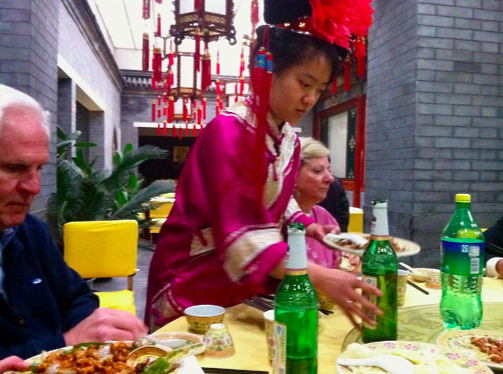 The next day we visited Lenovo and toured their innovation center and met with staff to discuss innovation. After lunch, we toured Baidu and then met with Kaiser Kuo, Chief of Investment Relations at Baidu and received a presentation from him on Baidu, the internet in China and innovation and entrepreneurship in China and how it differs from the U.S.  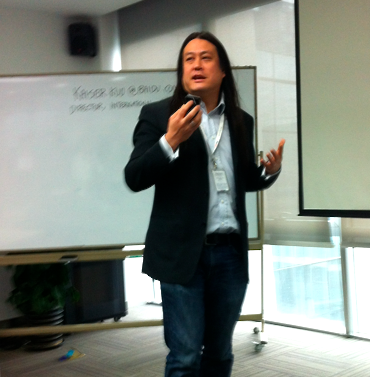
Pictures above: The Group at Baidu
(left) and Kaiser Kuo, Chief of Investment Relations at Baidu
who spoke with the group. Saturday was spent in visits to Tiananmen Square, the Great Wall, the Olympic Stadium (formerly named the Birdsnest) and shopping. On Sunday, the group toured the Forbidden City before going with us to the Southern High Speed Rail Station to take the High Speed Rail to Shanghai. The High Speed Rail travels at speeds of 300 kilometers and more and takes just over five hours to make the long trip from Beijing to Shanghai. Travel is in comfortable seats similar to business class airline seats and the ride is smooth and stable and quite scenic.    Pictures
above: The Beijing-Shanghai High Speed Rail. The train travels at
just over 300 kilometers per hour.
On Monday, we visited the Shanghai, KIC (Knowledge and Innovation Center) and heard from the Shui On who had developed the area on how the KIC was conceived and of its considerable success. Later we toured EMC, a large US multinational, which has a large innovation center in the KIC and is one of the larger tenants in the KIC. Finally, we also toured a new Chinese start-up company called Five Minutes which is building social interaction games using the internet. 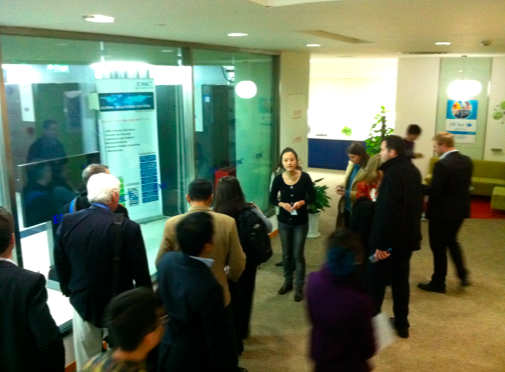 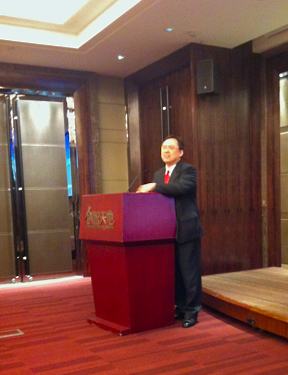  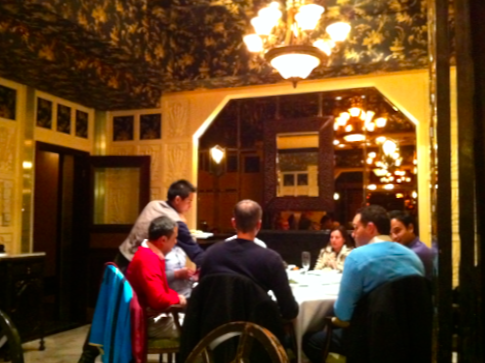 Pictures above: The group in
Shanghai. Top left picture is at EMC.
Top Right is Charles Chan from KIC and Shui On who spoke to the group. The next day we visited the Feng Pu Industrial Park and had a presentation by Jamie Zhang, Director of the Customer Service Department for the park and then later toured the export processing center inside the park and saw companies resident in the park. In the afternoon we visited a development in a former highly polluted steel factory that is planning to create one of the largest industrial parks dedicated to environmental protection and related activities. That evening we had a very fun and spectacular trip on a cruise boat just after dark in which we all marveled at Shanghai’s very impressive skyline and also at fireworks which were on display that evening. This was followed by the Concluding Dinner in a scenic restaurant which seeks to preserve Shanghai as it appeared in the late 30s. 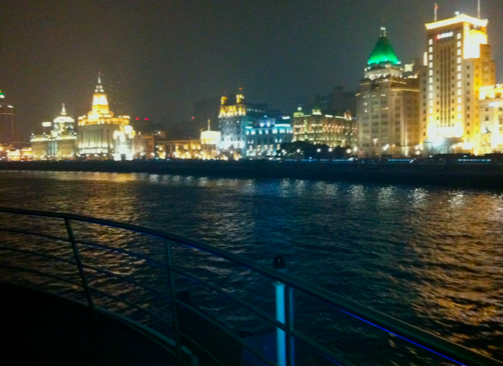  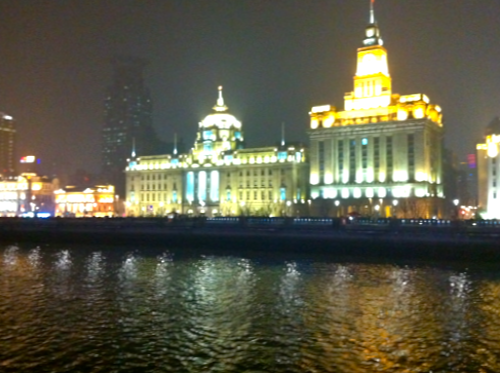  Pictures above: The night skyline in
Shanghai. In addition to the lights, the group watched a
spectacular fireworks show while on the boat. The final day of the program started
with a wrap-up session by Dr. Lindsey and Dr. Andy Rohm, an LMU
faculty, that helped the EMBA students to better reflect on what they
had seen and how it both was similar and also different from what they
had seen in the U.S. Later Christopher K. Beebe, General Manager
of SME Tec spoke to the group. Chris is a U.S. entrepreneur who
has build a successful sports supply related business based in Shanghai
and who has lived in Shanghai for six years. Chris spoke about consumer
behavior and how it relates to innovation in China. His
presentation was followed by a talk by Bob Gilman, CEO of
Pinpoint(China) Limited. Pinpoint is a business that helps its
client manage their credit card points and that is building success in
China.
  Pictures
above: Chris Beebe, General Manager of SME Tec (Right)
and Bob Gilman, CEO of Pinpoint speaking to the group. Throughout the 10 days together, we had seen much. Singapore’s road to building innovation was obviously different from both that found in the U.S. and that found in China. Further our talks with U.S. business had also shown much variance and many new and highly interesting ideas on ways to further build innovation. It was a great trip and I think all of us appreciated the learning that we had achieved and the added insights into Asia provided. About the Author: Christopher W. Runckel, a former senior US diplomat who served in many counties in Asia, is a graduate of the University of Oregon and Lewis and Clark Law School. He served as Deputy General Counsel of President Gerald Ford’s Presidential Clemency Board. Mr. Runckel is the principal and founder of Runckel & Associates, a Portland, Oregon based consulting company that assists businesses expand business opportunities in Asia. (www.business-in-asia.com) Until April of 1999, Mr. Runckel was Minister-Counselor of the US Embassy in Beijing, China. Mr. Runckel lived and worked in Thailand for over six years. He was the first permanently assigned U.S. diplomat to return to Vietnam after the Vietnam War. In 1997, he was awarded the U.S. Department of States highest award for service, the Distinguished Honor Award, for his contribution to improving U.S.-Vietnam relations. |
